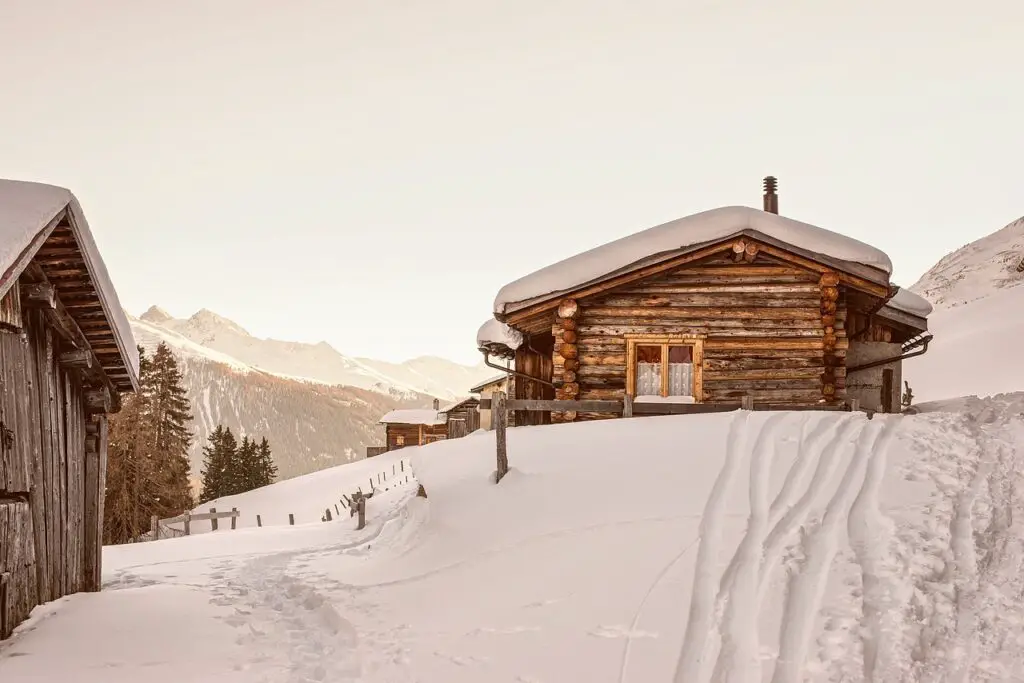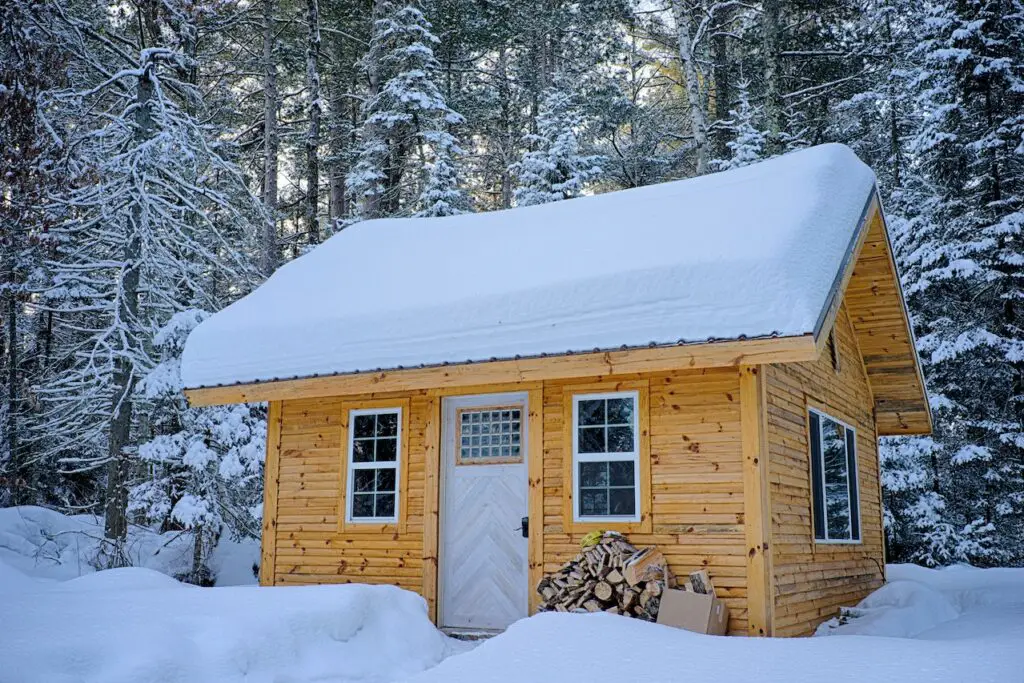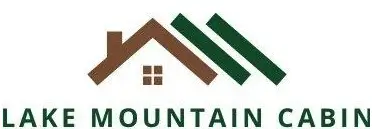Winter is a beautiful time of year — especially in a cozy log cabin nestled among snow-covered trees. Unless, of course, you’re freezing cold and worried about the condition of your cabin.
That’s why it’s crucial to properly winterize your log cabin to ensure comfort, safety, and energy efficiency during the cold months.
In this comprehensive guide, I’ll walk you through essential tips for cold weather preparedness, from inspecting your cabin for winter readiness to creating an emergency plan.

Inspecting Your Log Cabin for Winter Readiness
Before winter arrives, it’s important to conduct a thorough inspection of your log cabin to identify any potential issues that could impact your comfort and safety during the colder months.
Check for Drafts and Air Leaks
Drafts and air leaks around windows, doors, and other openings can trash your cabin’s energy efficiency and overall warmth. To identify air leaks, you can use a combination of visual inspection, touch, and even a candle or incense smoke test to see if there’s air movement near potential gaps.
Once you’ve located any drafts or air leaks, it’s time to seal them up.
Caulking and weatherstripping are two effective methods for sealing gaps around windows and doors. Here’s a quick video to show you how to caulk gaps around windows in your log cabin:
For larger gaps or cracks, you may need to use expanding foam insulation or replace damaged materials.
Inspect the Roof and Gutters
The roof and gutters are critical components of your log cabin, as they protect the structure from water damage and help maintain proper insulation.
Before winter sets in, carefully inspect your roof for any damaged shingles, leaks, or other signs of wear. Addressing these issues promptly will help prevent worse problems, such as ice dams or water damage, during the winter months.
Cleaning and repairing your gutters is another big winterizing task for some log cabins. Clear gutters of leaves, debris, and any blockages to ensure proper water flow. This will help prevent ice dams and potential damage to your cabin’s exterior.
Evaluate the Foundation and Exterior Walls
A solid foundation and well-maintained exterior walls are crucial for your log cabin’s structural integrity. Inspect the foundation for any signs of damage or wear, such as cracks, water damage, or shifting. Address any issues promptly to prevent more significant problems during the winter months.
Similarly, carefully examine your cabin’s exterior walls for any signs of decay, insect damage, or moisture intrusion. Sealing and treating any affected areas will help preserve your cabin’s structure and ensure it remains cozy and warm throughout the winter season.
Preparing Your Heating System
A reliable and efficient heating system is essential for maintaining a comfortable temperature in your log cabin during the winter months. Taking the time to properly maintain your heating system will help ensure top performance and minimize the risk of breakdowns or malfunctions.
Clean and Inspect Your Wood Stove or Fireplace
If you have a wood stove or fireplace in your log cabin, clean and inspect it before the winter season begins. Regular maintenance will help keep it efficient and safe.
Start by cleaning the firebox, removing ashes, and checking for any signs of damage or wear. Inspect the stove’s gaskets, door seals, and glass to ensure they’re in good condition. And replace any damaged components as needed.
Also, check your chimney and flue for creosote buildup, cracks, and blockages. A professional chimney sweep can perform a thorough inspection and cleaning to ensure your wood stove or fireplace is safe and ready for winter use.
Service Your Furnace or Heating System
If your log cabin relies on a furnace or another type of heating system, it’s essential to do regular maintenance to ensure it keeps working right through the winter months.
Check the system’s filters, cleaning or replacing them as needed. Inspect the blower, vents, and ductwork for any signs of wear, damage, or blockages.
Simple maintenance tasks like these can extend the life of your heating system and improve its efficiency. However, if you’re unsure about any aspect of the maintenance process or if you notice any signs of malfunction, it’s best to call a professional to inspect and service your heating system.
Install or Check Smoke and Carbon Monoxide Detectors
Smoke and carbon monoxide detectors are essential safety features in any home, including your log cabin.
Before winter arrives, ensure that you have working smoke and carbon monoxide detectors installed throughout your cabin, particularly near sleeping areas and heating sources.
Check the batteries in your detectors and replace them if necessary. It’s also a good idea to test the detectors regularly to ensure they’re functioning properly. If a detector is more than 10 years old, experts recommend replacing it with a new one.
Insulating Your Log Cabin
Proper insulation is key to keeping your log cabin warm during the winter months. If you address any insulation issues before winter arrives, you can minimize heat loss and reduce your energy costs.
Inspect and Upgrade Wall and Ceiling Insulation
To ensure your log cabin is well-insulated, start by inspecting the insulation in your walls and ceilings. In some cases, you may need to add or upgrade insulation to improve energy efficiency and maintain a comfortable indoor temperature during the winter months.
If you’re unsure about the condition or effectiveness of your cabin’s insulation, you may want to consult with a professional insulation contractor for an assessment and recommendations.
Insulate Windows and Doors
Windows and doors are common sources of heat loss in log cabins. Adding insulation around windows and doors can help reduce drafts and improve your cabin’s energy efficiency.
Weatherstripping is an effective method for sealing gaps around windows and doors, while caulking can help seal smaller cracks or gaps in the frame.
For additional insulation, consider installing window film or insulated window treatments, such as thermal curtains or cellular shades.
Insulate Floors and Pipes
Insulating floors and pipes can help prevent heat loss and protect your cabin’s plumbing system from freezing during the winter months. For floors, consider adding insulation beneath the floorboards or investing in thick rugs or carpeting to help retain heat.
For pipes, use pipe insulation or heat tape to protect them from freezing temperatures. This is especially important for pipes located in unheated areas of your cabin, such as crawl spaces or exterior walls.
Emergency Preparedness for Winter Storms
Being prepared for power outages and severe winter weather is crucial for the safety and comfort of your log cabin.
Stock Up on Essential Supplies
Before winter arrives, make sure you have essential supplies on hand in case of an emergency.
Here are some things to stock up on:
- Non-perishable food
- Bottled water
- Flashlights and extra batteries
- Emergency heating sources, such as portable propane heaters or wood stoves
- Blankets and warm clothing
- A battery-powered or hand-crank radio for weather updates
- A first aid kit and essential medications
Create an Emergency Plan
Having a winter emergency plan in place can keep you and your loved ones safe during a severe storm or power outage.
Your plan should include the following:
- Communication strategies for staying in touch with family members
- Evacuation routes and meeting points in case you need to leave your cabin
- A list of emergency contacts, including local authorities and utility companies
- Instructions for safely using emergency heating sources and other equipment
Protect Your Cabin While You’re Away
If you plan to leave your log cabin unoccupied during the winter months, it’s essential to take precautions to protect it from potential damage.
Consider doing the following:
- Draining pipes and turning off the water supply to prevent freezing and bursting
- Setting the thermostat to a temperature that will help prevent freezing, typically around 50 or 55 degrees Fahrenheit (10 to 13 degrees Celsius)
- Securing all doors and windows to protect against break-ins and storm damage
- Installing a security system or asking a trusted neighbor to keep an eye on your cabin while you’re away
- Removing snow and ice from the roof and gutters to prevent damage from ice dams and heavy snow loads

FAQs: Winterizing a Log Cabin
Do I need to worry about pests during the winter months in my log cabin?
Yes, pests can be an issue in log cabins even during the winter months because they seek shelter from the cold.
To minimize the risk of pests, seal any gaps or cracks in your cabin’s exterior, store food in airtight containers, and remove any potential nesting materials (like wood piles or clutter) near the cabin.
How can I prevent ice dams from forming on my log cabin’s roof?
Ice dams can cause significant damage to your log cabin’s roof and gutters. To prevent ice dams, ensure your cabin is properly insulated and has adequate ventilation in the attic.
Regularly removing snow from the roof using a roof rake and keeping gutters clean will also help prevent ice dams from forming.
Also, if you have some extra room in the budget, you can install heat tape or heat cables on parts of your cabin’s roof that are prone to ice dams.
What is the best way to maintain my log cabin’s wood exterior during the winter months?
Proper maintenance of your log cabin’s wood exterior is essential for protecting it from winter weather damage. Regularly inspect the logs for signs of decay, insect damage, or moisture intrusion, and treat any affected areas promptly. And apply a high-quality wood sealant or stain to protect the logs from moisture and UV damage.
How can I improve the energy efficiency of my log cabin during the winter?
To improve energy efficiency in your log cabin, focus on proper insulation, sealing air leaks, and maintaining your heating system. Insulate walls, ceilings, windows, doors, floors, and pipes to minimize heat loss. Also, regularly maintain your heating system, clean filters, and inspect the system for any potential issues.
Is it necessary to winterize my log cabin if I only use it occasionally during the winter months?
Yes, it’s still essential to winterize your log cabin even if you only use it occasionally during the winter.
Proper winterization protects your cabin from potential damage due to freezing temperatures, snow, and ice. Additionally, it ensures that your cabin remains safe and comfortable when you do visit during the winter months.
What steps should I take to prepare my log cabin’s plumbing system for winter?
To prepare your log cabin’s plumbing system for winter, insulate pipes located in unheated areas or near exterior walls. And drain any water from outdoor faucets and hoses.
If you plan to leave your cabin unoccupied during the winter, turn off the water supply and drain the pipes to prevent freezing and bursting.
Prepare Your Cabin for the Winter Now, Not Later
Winterizing your log cabin is key to ensuring your comfort, safety, and energy efficiency during the cold weather months. By taking the necessary steps to inspect, maintain, and prepare your cabin for winter, you’ll be able to enjoy the beauty and tranquility of your log cabin retreat all season long.
So, grab a warm blanket, a cup of hot cocoa, and start preparing your log cabin for the winter season. Your efforts will fully pay off when you’re able to relax in a cozy, warm, and safe space, surrounded by the pristine beauty of a winter wonderland.
